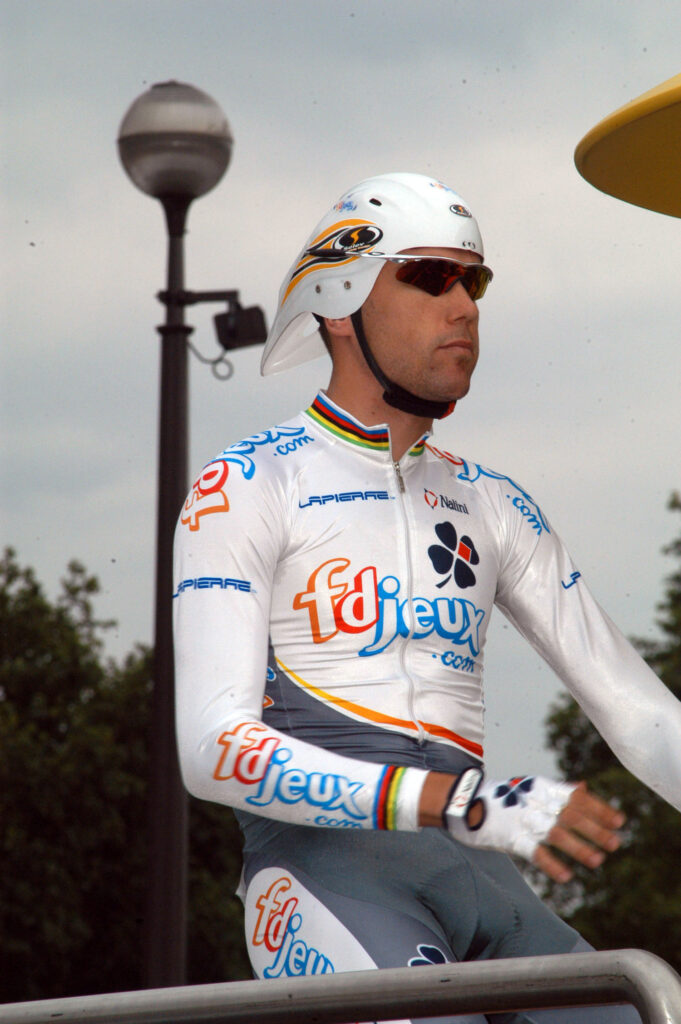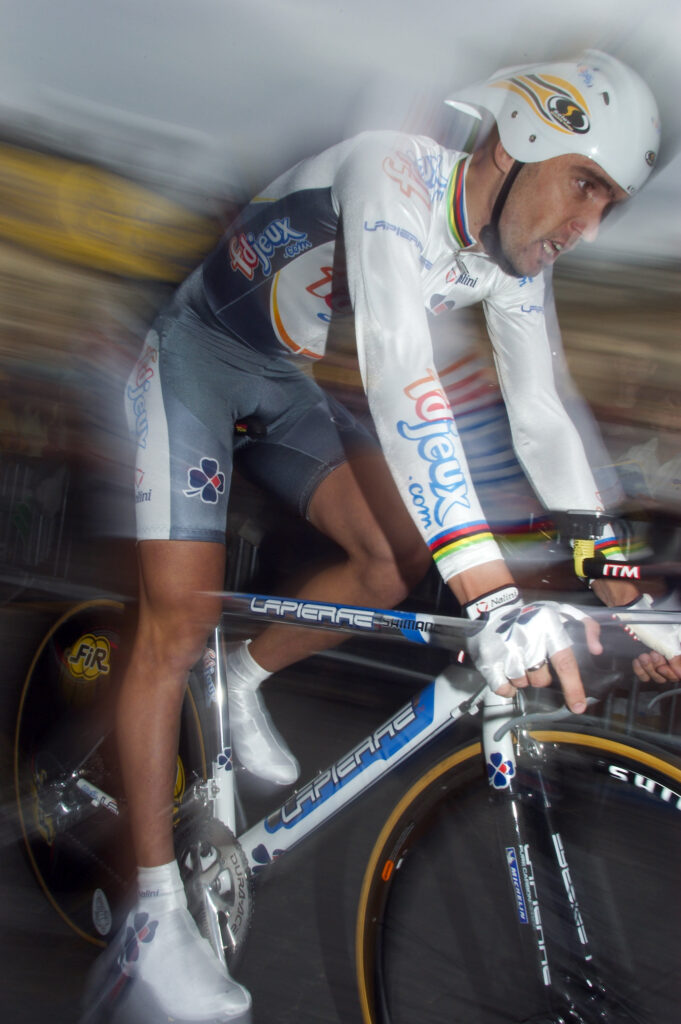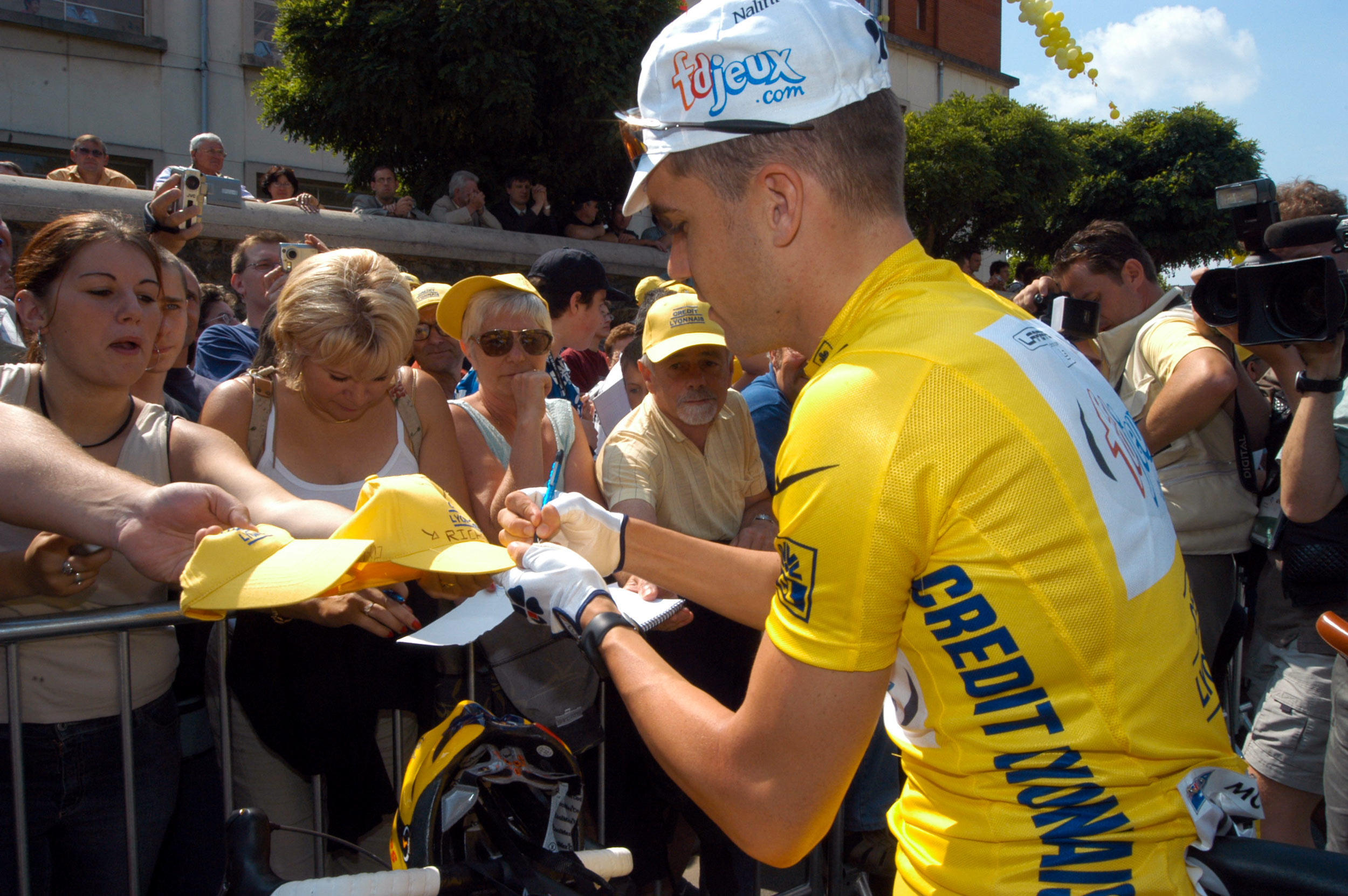As we countdown to the Tour de France of 2023, RIDE Media – publisher of the Official Tour de France Guide (Australian edition) – will be presenting a series of articles about the race.
This is a flashback to almost 20 years ago when Bradley McGee won the prologue in Paris and became the third Australian to wear the yellow leader’s jersey.
– By Rob Arnold.
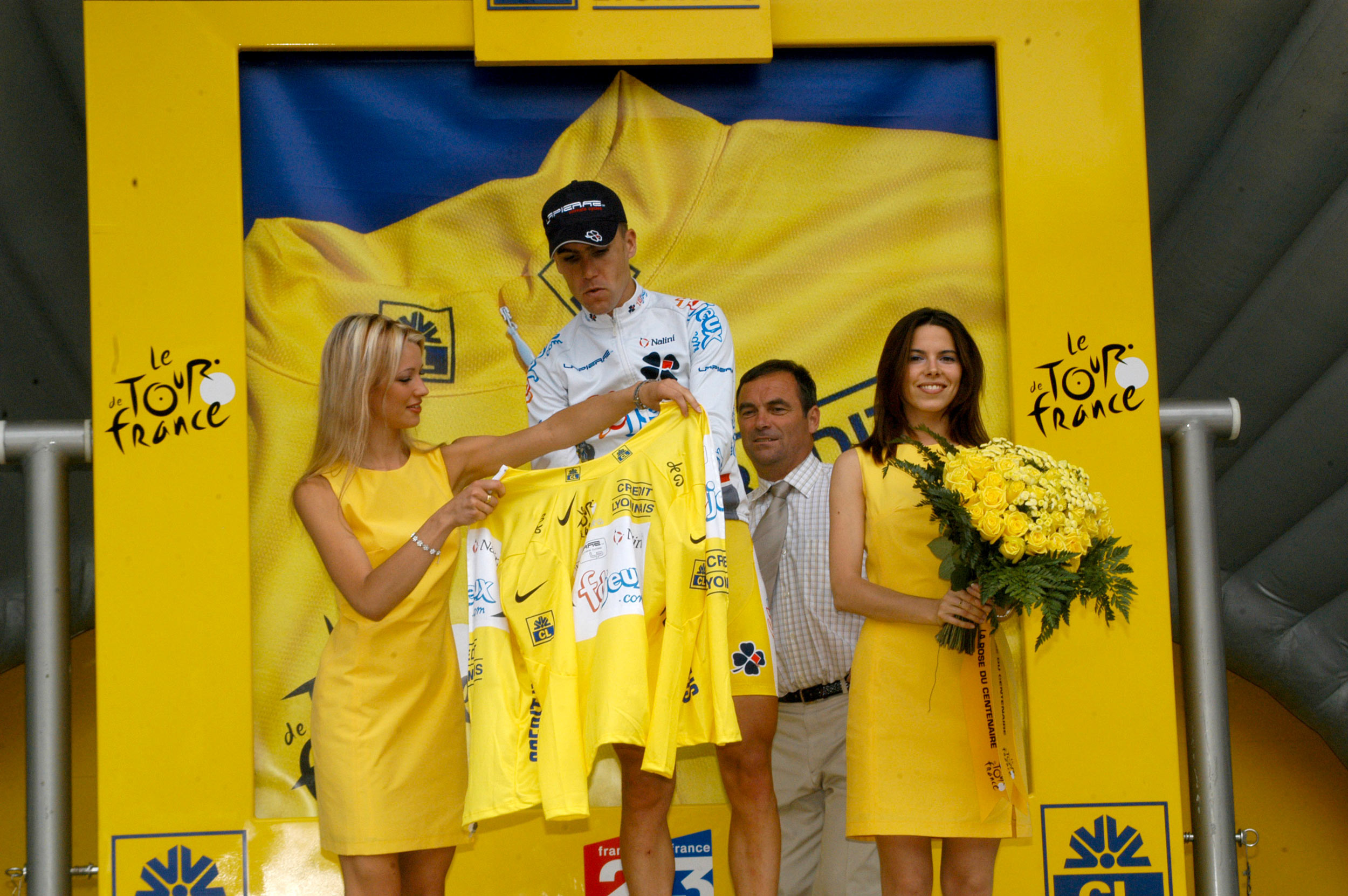
Brad McGee became the third Australian to wear the yellow jersey at the Tour de France after he won the time trial on the opening day of the 2003 race. (Photo: Sirotti)
The Grand Départ of every Tour de France is a special occasion, a gathering of the world’s finest cyclists who arrive in peak form ready for the challenge that awaits over the following three weeks of competition. And in 2003 the start was bigger and bolder than ever before as it marked the 100th anniversary of the first edition.
That year race organisers paid tribute to the original TDF by visiting each of the cities that hosted a stage finish of the original race in 1903.
The start of the 2003 Tour was in Paris and, with the Big Loop going in a clockwise direction around France, it would include stage finishes in Lyon, Marseille, Toulouse, Bordeaux, and Nantes before returning for the finale in the French capital.
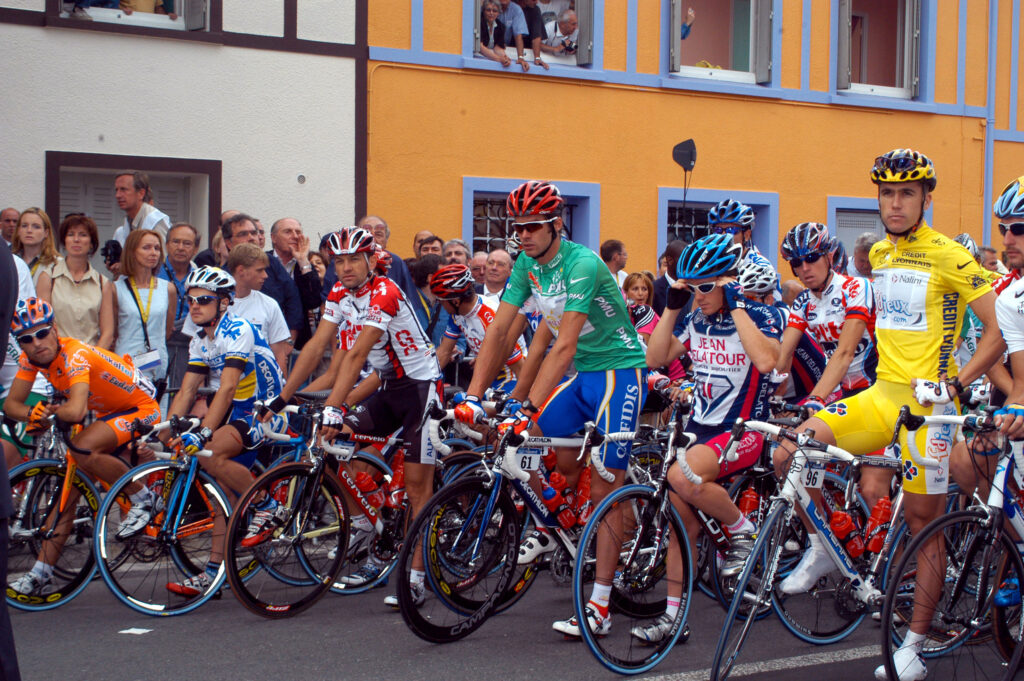
McGee claimed both the yellow and green jerseys with his win in Paris, but David Millar – the runner-up in the prologue by a fraction of a second – is seen here in the maillot vert with McGee in yellow before the start of stage one. (Photo: Sirotti)
The ‘centenaire’ was not, of course, the 100th edition as there were 10 years interrupted by war. Still, a celebratory mood was omnipresent in 2003 when the long history of the event and its growing influence on the culture of France – and the sporting world – were highlighted throughout the three weeks of competition.
In the 2003 TDF the Australian influence was significant at the start, thanks to Brad McGee’s win in the 6.5km prologue in Paris. He beat pre-race favourite David Millar – winner of the opening stage in 2000 – by just 0.08sec to become the third Australian to wear the maillot jaune.
Three weeks later, on the final day of the 2003 Tour, McGee would also play a pivotal role in helping his FDJeux.com team-mate Baden Cooke claim the green jersey as winner of the points classification in a battle royale against his compatriot (and defending champion of the sprinters’ category) Robbie McEwen.
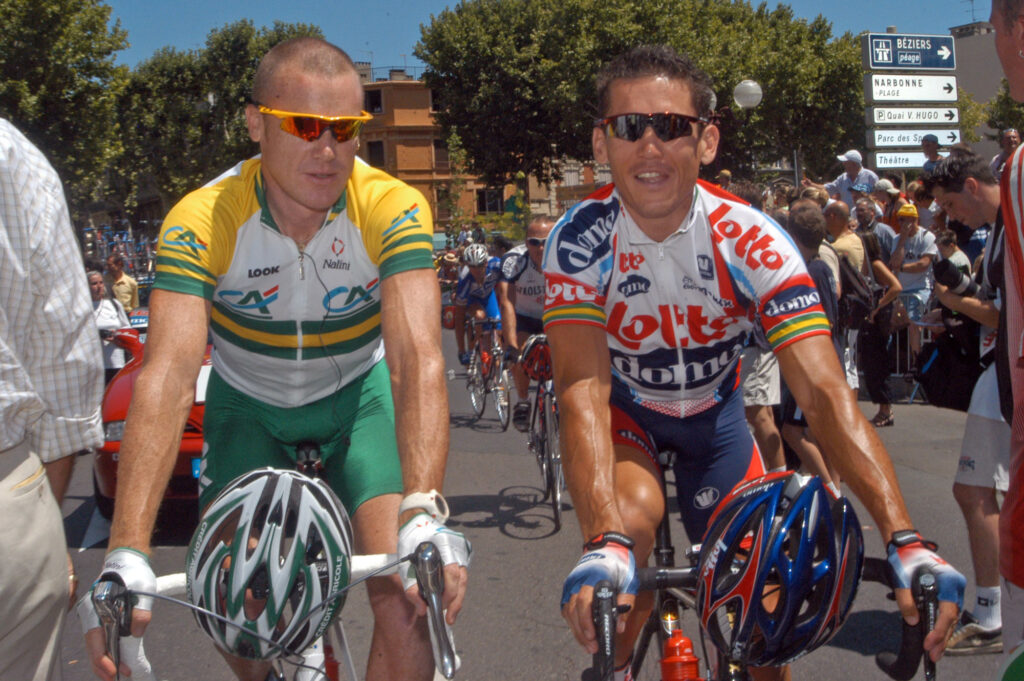
Stuart O’Grady and Robbie McEwen, two of the seven Australians in the ‘centenaire’ of the TDF… both riders have also worn the Tour’s yellow jersey. (Photo: Sirotti)
There were seven Australians at the start of the Tour in 2003: McGee and Cooke along with Matt Wilson as part of the FDJeux.com team; Michael Rogers making his Tour debut with Quickstep-Davitamon; McEwen and his good mate Nick Gates at Lotto-Domo; and the Aussie champion at the time Stuart O’Grady racing with the Crédit Agricole team.
Adding to the Australian flavour in the race that year, O’Grady – the second Aussie to wear the yellow jersey (which he did in 1998 and again in 2001) – won the Prix du Centenaire, as the most consistent finisher in each of the five original stage finish cities.
Remembering the beginning
On 5 July 2003, 100 years to the day after the Tour’s original Grand Départ, there was a time trial prologue in Paris. Starting at the base of the Eiffel Tower, the 6.5km circuit looped through Paris and finished on the Avenue de la Motte-Picquet on the eastern end of the Champ de Mars.
It is almost 20 years since McGee’s victory in that time trial and RIDE Media recently caught up with him to discuss his days as leader of the Tour de France.
When we spoke, McGee was in the gym at his current workplace, the NSW Institute of Sport. He had just clipped into the pedals on an indoor trainer for a late-afternoon workout.
“It’s kind of apt that I’m on the bike,” he said after explaining what I wanted to talk about. Then, with a laugh, he added: “I’ll get into the aero position while I’m talking to you.”
The prologue win was achieved with equipment that, in today’s terms, seems positively archaic: a Scandium framed Lapierre TT bike with external cables, bar-end shifters and old-school (non STI) levers fastened to ITM aerobars.
He wore a long-sleeve skinsuit that he now admits was “baggy as hell” but this was his preference at the time. “I wanted it to be comfortable,” he says laughing at the memory of his clothing choice.
His Selef helmet was TT-specific but so small that he began the prologue with the arms of his Oakley sunglasses positioned over his helmet. “I remember it well and I can say that I ripped them off halfway through the race.”
While recalling the bike and kit he used, McGee continued laughing before giving an overview of what it was all like.
“Oh, looking back, I couldn’t have done much worse.
“The skinsuit was bad. The helmet? Bad! Sunglasses? Bad! Tyres? Bad! Frame? Bad!
“The way the cabling was done: bad…! The booties? Bad!
“I don’t think I got anything right.
“But at the time, obviously, that was all we had. It was more about the watts, mate. And holding your shit together.”
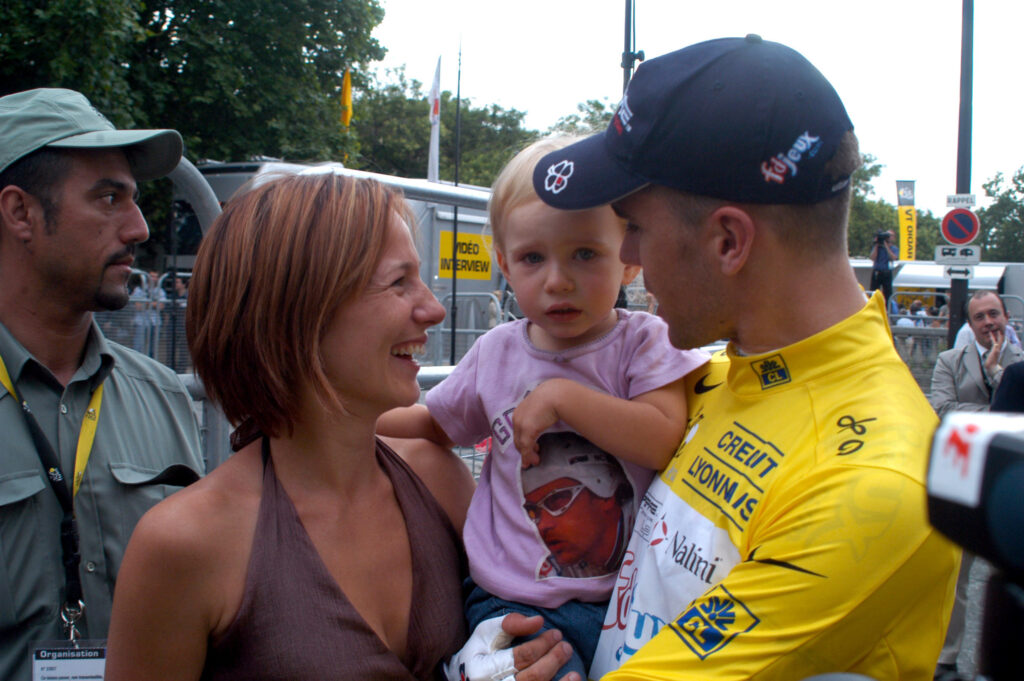
The McGee family after the podium protocols. Left to right: Sharni, Tahlia and Brad. (Photo: Sirotti)
Leader of all three Grand Tours
Twenty years on, McGee remains involved in sport with a senior position in the coaching staff at NSWIS and the lessons of his racing days continue to serve him well. He was a pioneering cyclist who caught the attention of the FDJ team manager, Marc Madiot, while still a teenager.
After making his Olympic debut in 1996, winning two bronze medals on the track (team pursuit and individual pursuit) in Atlanta, he shifted focus to road racing and his time trialling ability was a key component of his versatile repertoire.
By the end of his racing career (cut short by a back injury during his only season with Team CSC in 2008) he’d worn the leader’s jerseys of all three Grand Tours. The maillot jaune, worn for three days after his prologue win in Paris, was the first.
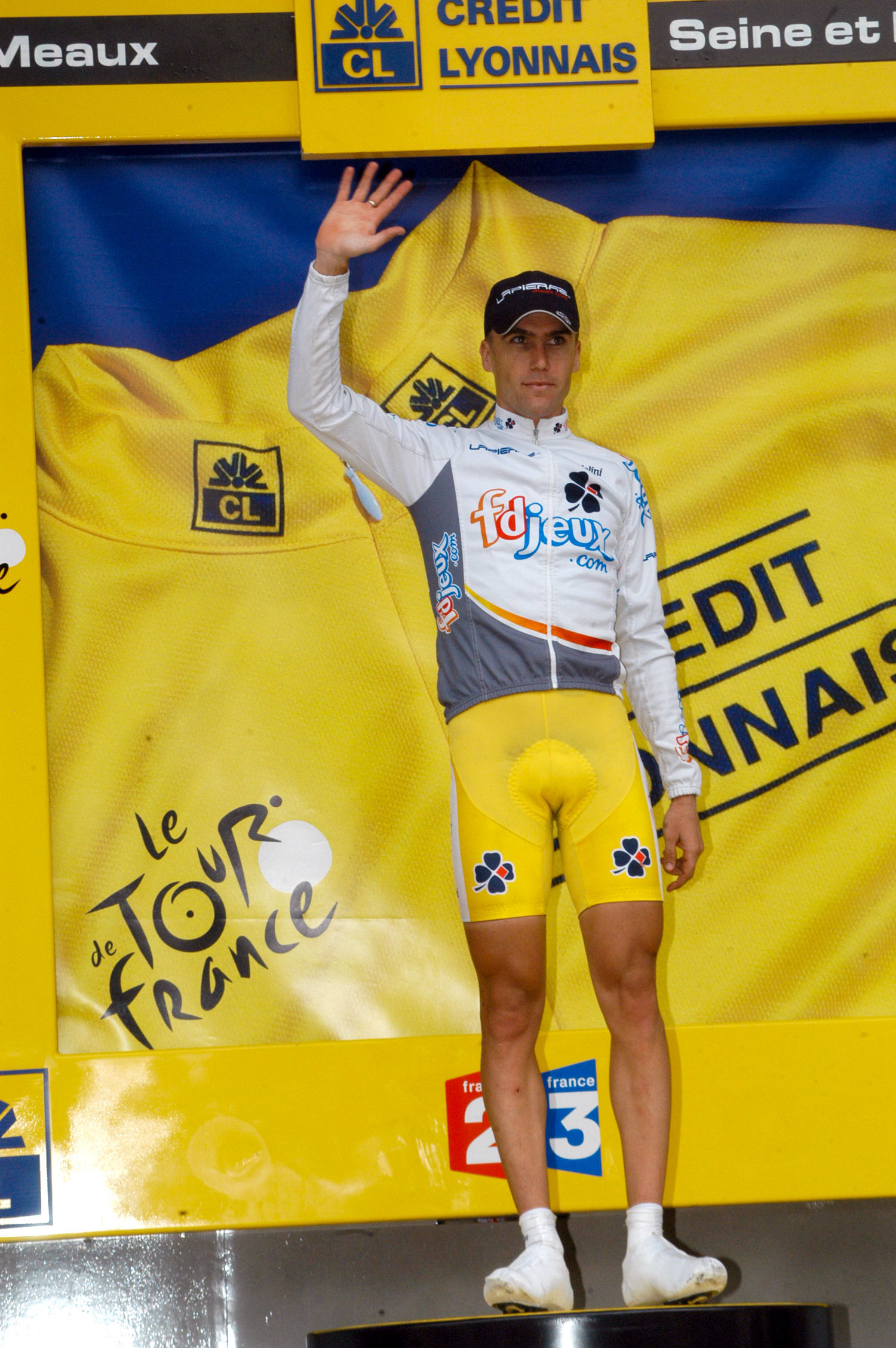
In 2003 it was common to have knicks to match the prize jerseys… even during the early stages of the Tour de France. (Photo: Sirotti)
In 2004, he won the prologue of the Giro in the same edition in which he finished eighth on GC, his only top-10 result in a three-week race.
In 2005, he was third in the opening stage of the Vuelta (a time trial) then placed second in stage two to claim what was then a golden leader’s jersey which he wore for four days in the first week.
There were plenty of other highlights from McGee’s time in professional cycling that also included a stint as directeur sportif of the Saxo Bank-Tinkoff team, when he helped guide Alberto Contador to a stunning victory in the Vuelta a España in 2012.
It was in Paris in 2003, however, that McGee enjoyed two of his most memorable conquests. Curiously, his highlight of that year’s Tour was when the race returned to the French capital and he helped his team-mate Baden Cooke win the green jersey with a memorable final sprint that concluded the centenaire edition.
McGee’s days in yellow were the only time any rider from Madiot’s team led the TDF, and it came about in interesting circumstances which included a few mechanical issues – notably a dropped chain for his main rival in the prologue David Millar, the winner of the Tour’s opening stage in 2000.
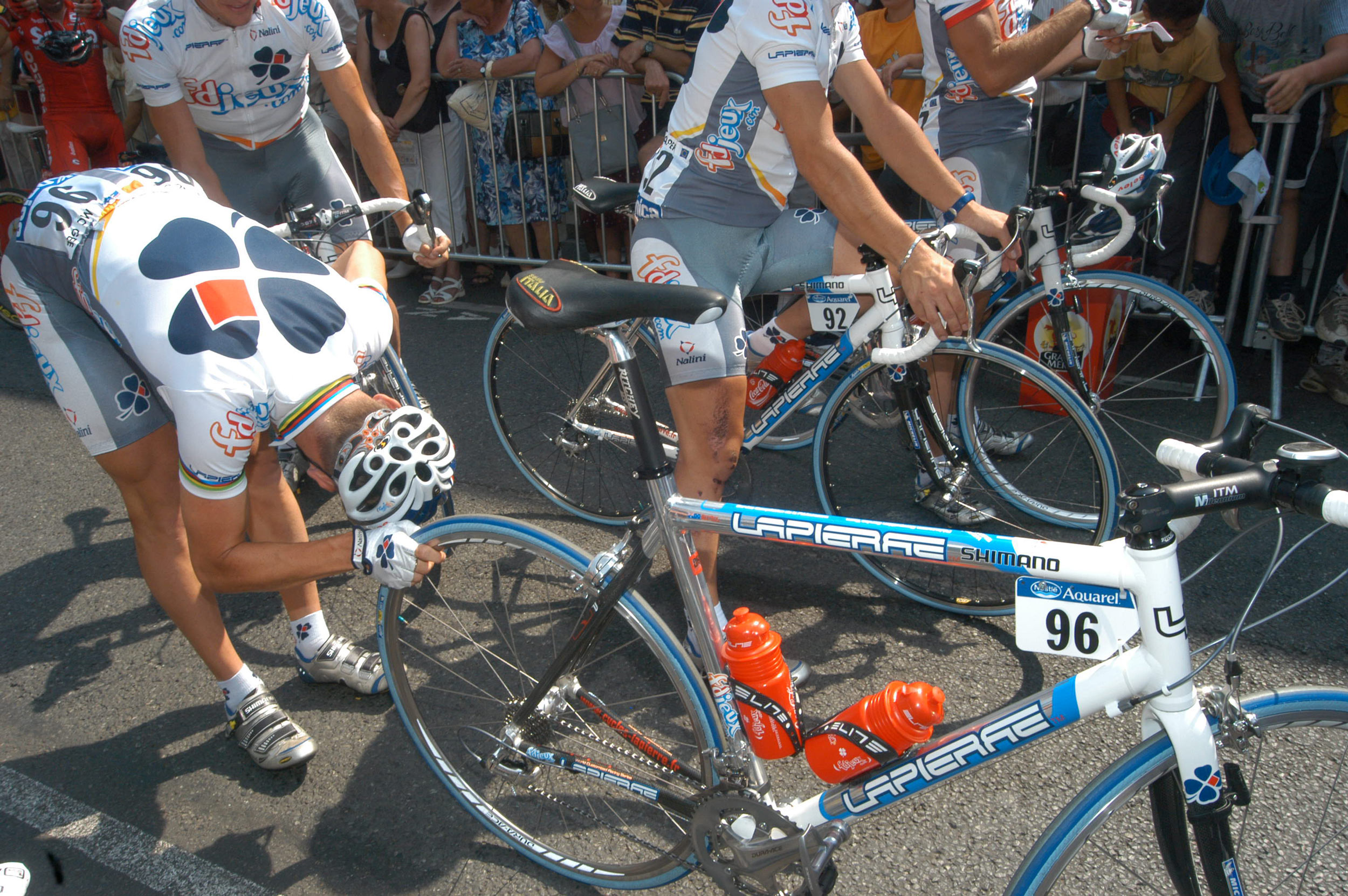
Lapierre bikes raced at the Tour have changed dramatically in the 20 years since McGee took the yellow jersey. (Photo: Sirotti)
#StoryOfMyBike: Mark Renshaw explains his FDJ team-issue Lapierre
High anxiety… thanks to good form
It’s not easy to close down a city the size of Paris for the sake of a bike race, but the 100th anniversary called for special measures even if it meant there was limited time to get familiar with the course. And McGee begins his recollections of the big day explaining how anxious he was because he knew he had the form to win.
“On the day of the competition it was The Most Nervous pre-race I experienced,” he says, adding emphasis to his state of mind.
“The logistics of getting on the course meant it was very tough to get an understanding of what to expect. Essentially, the only time we got to ride it was on the day of the competition, in the morning.
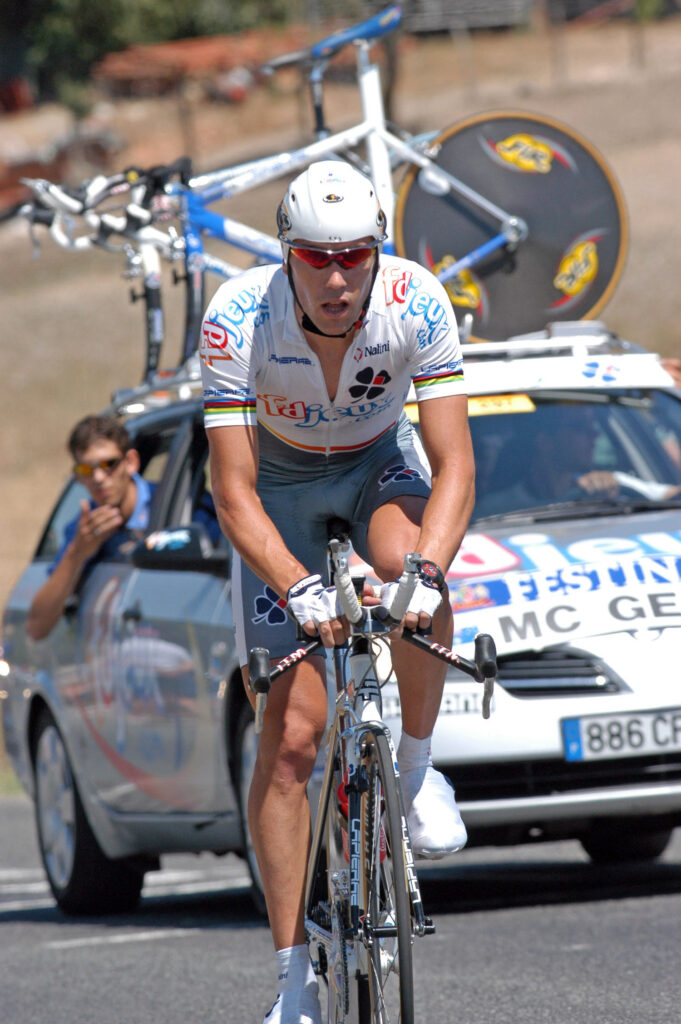
McGee would eventually finish his third TDF ranked 133rd on GC… here he is in the time trial of stage 13. (Photo: Sirotti)
“We were staying on the outskirts of Paris, and we travelled into the city, did our recon on the course while the roads were closed, and then rather than travel all the way back out to our accommodation, we decided to get another hotel room for me right near the start line and just wait.
“But what that meant is that I could hear the commentator, Daniel Mangeas, all day. He was building up all the hype while I was trying to relax in a hotel room by myself and honestly there’s no other way I can say it: I emptied myself. I was just on the toilet for what seemed like about three hours straight, and it was from pure nerves.
“And the only way I could console myself was to start watching TV and there was a long political essay being delivered by Nicolas Sarkozy, the future president of the Republic, and I got transfixed – mesmerised – by his style of delivery. That was the only thing that relaxed me.
“Apart from that, the main memory I have of the pre-race was that I was, literally, shitting myself from nervousness.
“And I was so nervous because I knew I was so on. I never felt so ready before that day.”
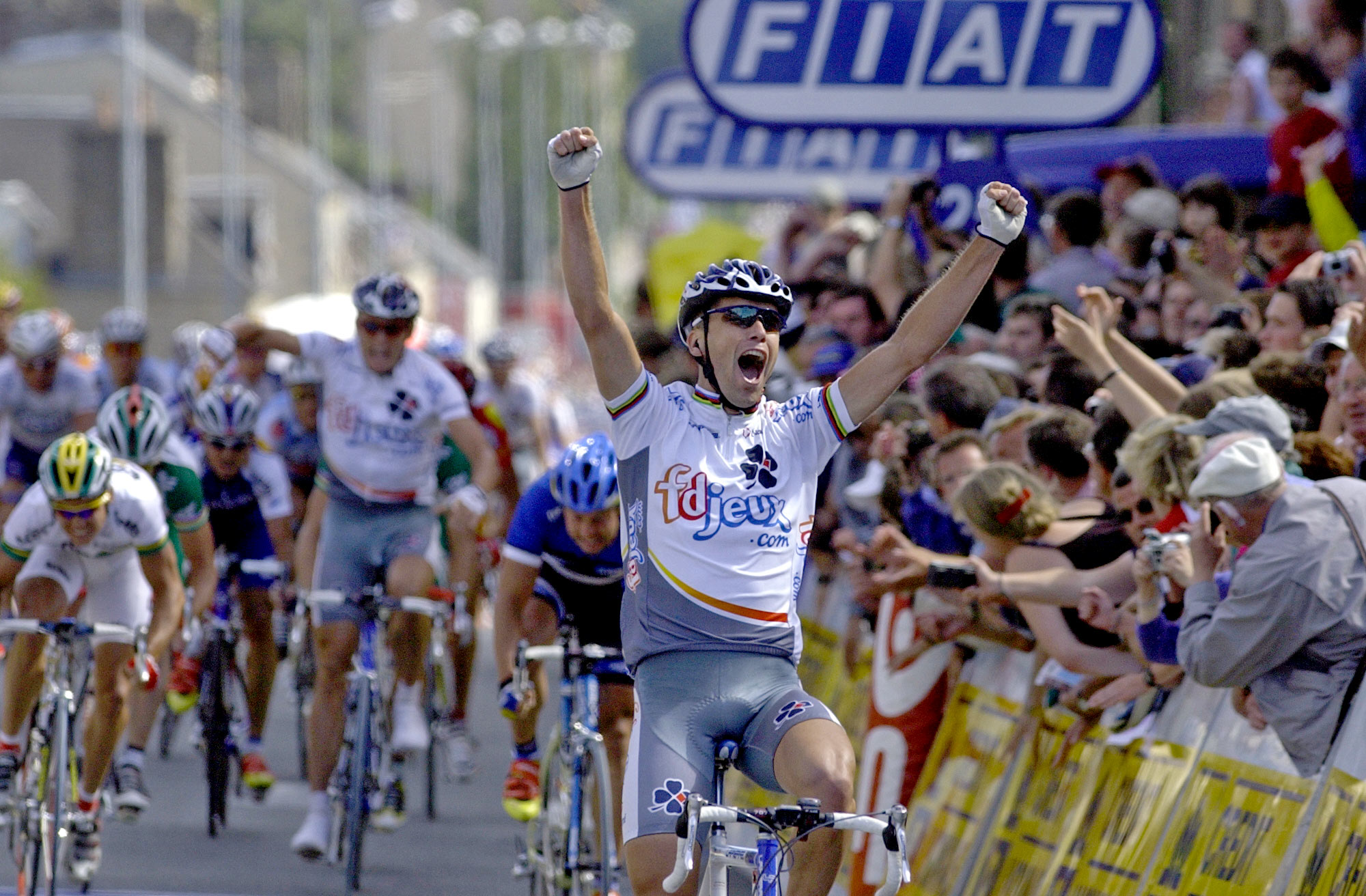
Before his days in yellow… McGee won the seventh stage of the 2002 Tour with late burst of speed at the finish in Avranches. (Photo: Graham Watson)
The 2003 Tour was McGee’s third. In his debut two years earlier, he was in a breakaway in stage 16 along with escape specialist Jens Voigt who’d worn the yellow jersey for one day earlier in the race. On a scorching hot day to Sarran, he swapped off while he could but in the closing kilometres McGee says he almost blacked out from the effort; he wasn’t able to contest the stage, won easily by Voigt.
The next year, when Cooke made his Tour debut, Madiot and co hatched a cunning plan for the uphill finale to Avranches at the end of stage seven.
After four top-10 places in the opening week, it was obvious that Cooke was the FDJ team’s sprinter and thus somewhat of a marked man. And so the Aussie pair pulled off a coup that saw McGee not only muscle his way to the front in the final kilometres but attack at the base of the last climb.
He opened a gap and maintained it with a stunning display of strength and celebrated his first Tour stage win in style, catching the sprinters by surprise and holding them off all the way to the finish.
With one win already on his CV, McGee’s status in the bunch was elevated and by 2003 he had matured into a seasoned pro. He had a reputation and the confidence to prepare specifically for the Parisian prologue and ultimately this single-minded approach paid dividends.
“I was confident I knew how to prepare to land the big one on the day,” he says 20 year later. “The course suited me. I had really good prep prior.
“I just felt invincible really, and that’s why I was so nervous. It was like, ‘Holy shit, this thing is really happening.’”
Winning with a puncture
It was a largely flat course for the 2003 prologue in Paris and Brad McGee had the benefit of having a relative in the car that followed him for the time trial.
Marc Madiot was in the team for motivation and inspiration, calling encouragement through the two-way in a manner that has become part of cycling legend. Beside the excitable French team manager was Rod McGee, one of Brad’s three older brothers. They had raced and trained together for years, even winning a world title in the team pursuit in 1995, when the youngest sibling was still a teenager.
Rod’s presence is one of the things that helped tame Brad’s nerves on the day of the prologue. And together they nutted out something of a plan for how the TT would be ridden.
“I rode a 55 on the front and a 48 on the inside ring,” explains Brad about the specifics of his equipment.
“I actually started in the little ring as there was a little rise for about 500 or 600 metres and I didn’t want to start in a 42 or a 39 so I decided to go for a 48 inside ring. It actually forced me to hold back for the first kilometre.”
It may have been a short time trial but McGee admitted that he didn’t go as hard as possible straight off the start ramp.
“Basically, that first climb accounted for the pacing strategy,” he says. “After that it was full gas for the rest of the course!”
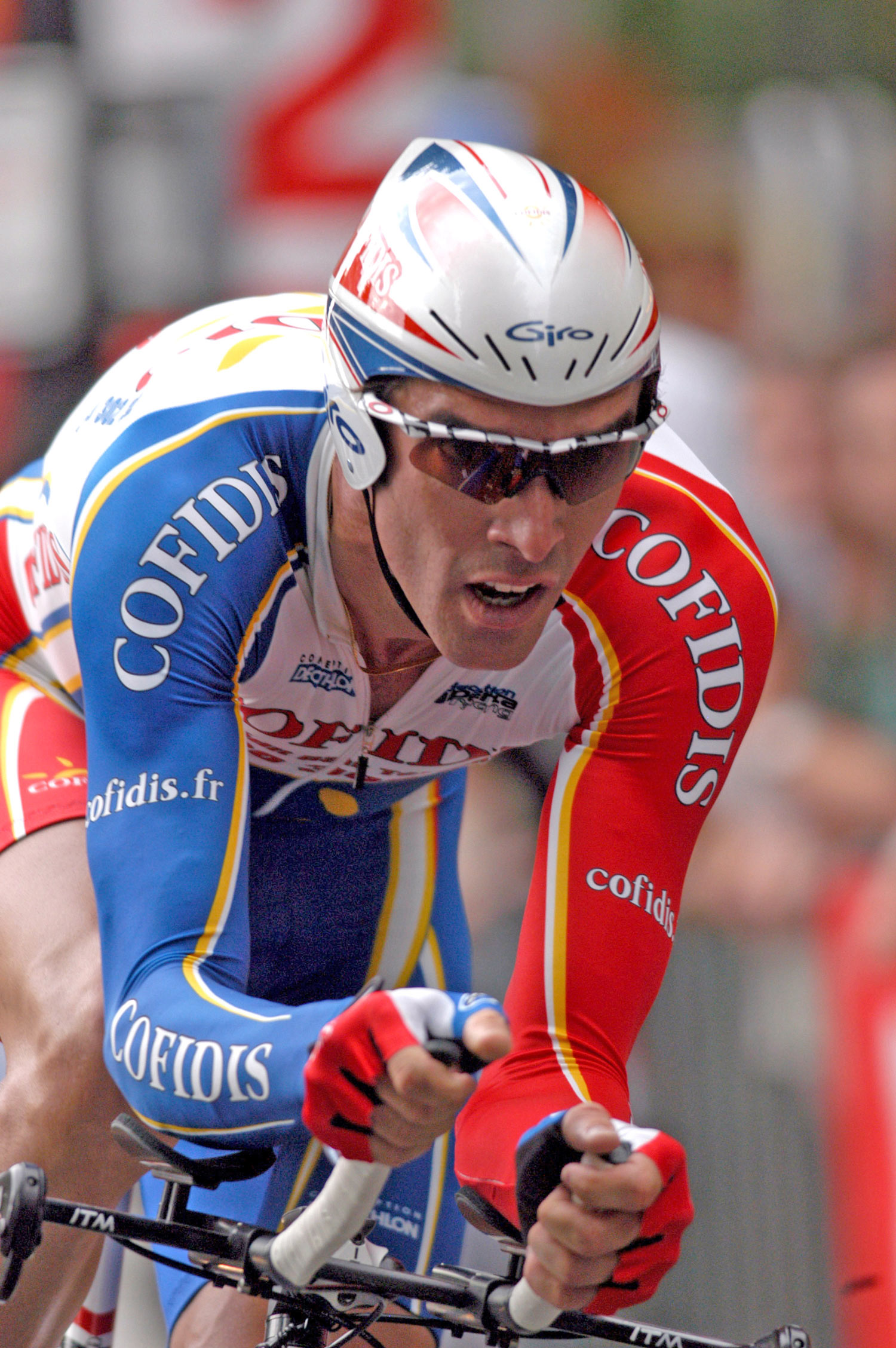
David Millar in the prologue… he would finish second, just 0.08sec behind McGee despite dropping his chain twice. (Photo: Sirotti)
As it turned out, Millar would indeed become McGee’s closest challenger and FDJ’s days in yellow may never have happened had it not been for a mechanical error by the Scotman’s Cofidis team.
“Dave dropped his chain twice,” McGee explained about how a bit of misfortune for a rival benefited him in Paris. “He famously decided to go with one chainring and his team mechanics took off the front derailleur, thinking you don’t need it because you’ve only got one chainring and you don’t need to change that gear.
“But what we know is that the derailleur can also act as a chain guard and holds the chain on. A lot of the circuit was rough roads if not cobblestones and Dave never managed to get the best out of his bike…”
The dropped chain incident(s) weren’t the only issues for the two fastest riders in Paris.
“It was a pretty rough ride,” says McGee about the circuit which included sections on Paris’ cobbled avenues.
“Not a lot of people know it, but I finished with a puncture. My rear tyre was dead flat.
“We think it happened at some point in the last 500 metres.”
McGee looks back on the day with enormous fondness but, he insists, even if he’d been beaten he wouldn’t have been disappointed.
“Millar was the red-hot favourite but all I was focussed on – and all I delivered – was the absolute perfect ride for what I could do that day.
“I was in that happy place where, even if you get beaten, you can’t be too upset because you know you couldn’t have done any more.
“We were all rushing through every corner and pushing the limits to an extreme,” he concludes about that special day that turned an FDJeux jersey into a yellow one.
“It was insane. It was just nuts. It’s a great memory.”
– By Rob Arnold
RIDE Media will be publishing a series of TDF flashbacks as we approach the Grand Départ of the 2023 race.
Be sure to pre-order your Official Tour de France Guide (Australian edition) before the race starts on 1 July 2023.



